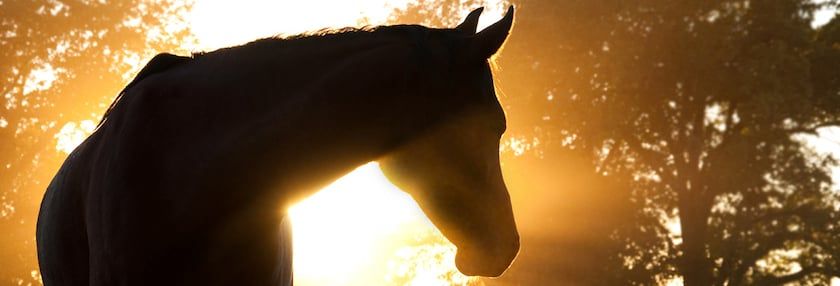‘What Has Gotten Into You?’


Avoiding boredom and burnout with your horse
Have you ever found yourself driving to a regular destination and thought, “I just can’t stand to look at the same stretch of road one more time?” Maybe that’s the day you tried a different route, just to mix things up a little.
I’ve often wondered whether horses feel the same way.
Most days, I saddle my mare in the same spot, walk her to the same arena, and ride her for about the same amount of time. I think about each of those rides very differently in terms of my goals for myself and for her, but from her perspective, they’re probably more alike than they are different.
I try to avoid anthropomorphizing horses too much—after all, understanding the way they experience the world is more helpful to managing their welfare than assuming they feel the same way we do.
However, when a horse goes from a steady, reliable, workman type to grumpy and sour, you do have to wonder what’s going on. Do horses experience burnout? And if they do, what can you do to help?
Equine researchers have yet to diagnose horses with “burnout” as such, but do seem to agree that they can experience boredom. Knowing whether boredom is to blame for a change in behavior, however, can be complicated.
Discomfort can sour attitude
Attitude changes can be symptoms of physical pain or distress. As prey animals, horses are programmed to hide weakness and some are more known to be more stoic than others.
The first thing to do when you see a change in your horse’s behavior is consult your veterinarian.
Remember, discomfort associated with work may not be lameness of a limb; dental issues can make previously comfortable bits unfriendly, chiropractic problems can make a particular activity harder than it once was. Gastric ulcers are extremely common in horses and can manifest with a variety of frustratingly nebulous symptoms, including irritability and poor appetite.
Sometimes, the underlying physical problem may be more complex and challenging to uncover. In a presentation before the American Association of Equine Practitioners in 2005, Dr. Sue McDonnell of the University of Pennsylvania described several cases she had been consulted on for sudden behavioral changes. Sometimes, she said, those behavior changes could be atypical spookiness or fearfulness, while other times they were more violent, self-harming reactions to a work environment.
McDonnell recalled one mare who demonstrated reduced performance as a racehorse and an increasing unwillingness to work; when she was retired to become a broodmare, a reproductive examination revealed a granuloma cell tumor weighing over 60 pounds.
Another horse developed a sour attitude punctuated by episodes of mild colic and finally, violent rearing. After some time and presumably puzzlement from her handlers, she was finally diagnosed with an intestinal abscess, which was being caused by a wire twist tie she had ingested at some point.
That doesn’t mean the root cause of a new attitude is always so dramatic or singular.
“In some cases, we find that a horse may have a number of seemingly minor physical problems, each of which alone would be judged unlikely to be the sole cause of a behavior problem,” McDonnell wrote. “We sometimes conclude that the problems together are the cause of the behavior problem.”
Is it all in the mind?
In the absence of an identified physical issue, it is worth considering whether the horse is getting enough mental stimulation.
Horses that are stallbound when recovering from illness or injury can often be known to pick up a new behavior like wood chewing, seemingly as a way to pass the time or relieve stress. Others may develop those behaviors when kept on a schedule that restricts turnout time.
Often, the remedy is to find something for their active brains to focus on—hay in a hay net, which slows down consumption, is a good start.
Designing or modifying a stall to give a horse good ventilation and a line of sight to pasture mates can also provide relief, probably because it’s less restrictive.
Some horses respond well to stall toys, particularly those that include edible or lickable treats, though I’ve known more than a few who find a way to break the toy and gobble up the treats in a few minutes, given enough practice.
Check out the herd
Take a look at herd dynamics, too. A horse who’s being stressed or harassed in the field is bound to become overwrought or tired, which could carry over into their attitude in the barn. This is especially true if the herd has recently lost or gained members, or moved pastures, as these changes can “shake up” a previously-established totem pole of leadership and stir up fights.
Watch horses on their own in the field, particularly if they’re fed outside.
Barn and lesson program managers of equine therapy programs have begun noticing a tendency for horses in those facilities to appear sour or burned out after too long in the job.
Routine is important to prevent anxiety, but experts at the Professional Association of Therapeutic Horsemanship International (PATH) suggest mixing things up occasionally – taking a horse for a trail ride or lunge line outing during the week to diversify their standard walking exercise.
Adding poles or other obstacles in a familiar space like an arena or riding field can also provide a new mental challenge without the need to go off-property.
Tags:Horse Sense

Acreage Life is part of the Catalyst Communications Network publication family.
















